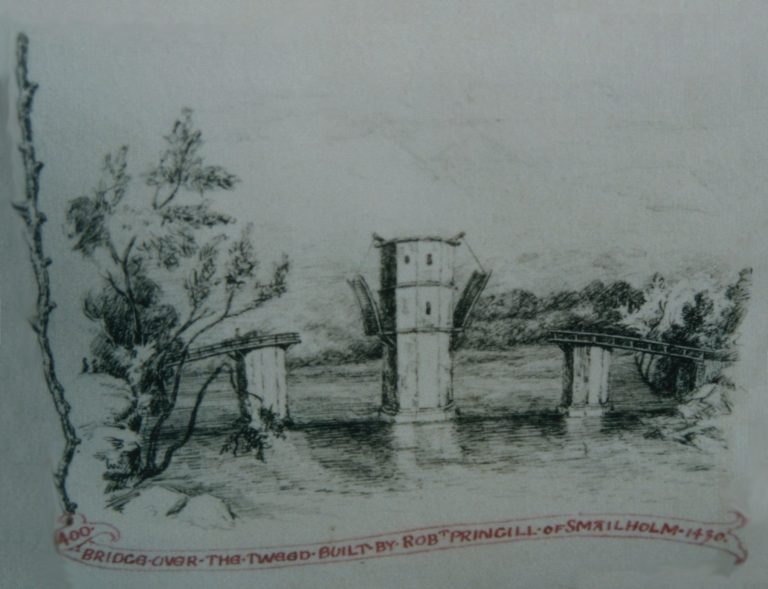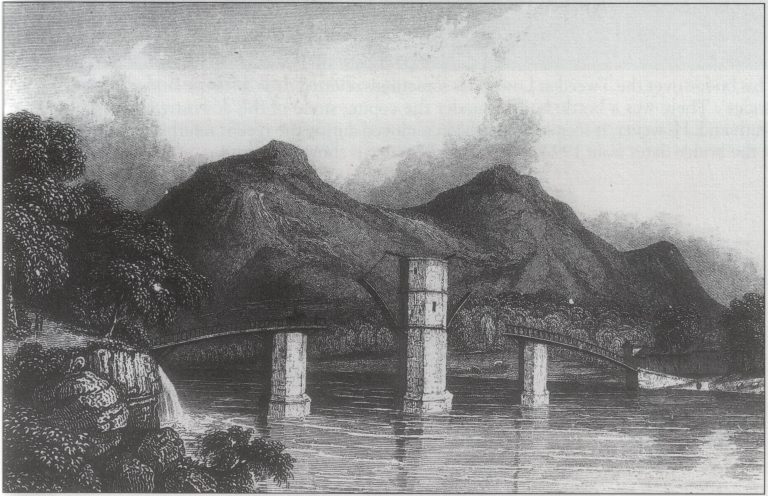Pringill's Brig
Pringill's Brig (Pringle’s Bridge)
In medieval times, an important bridge crossed the Tweed just below the joining of the Gala Water. It was on the pilgrims main route between Melrose Abbey and Soutra Monastery. This Bridge was known as ‘Pringill’s Brig’ and was either built by or repaired by Robert Pringill (or Hoppringill), 2nd Laird of Gala about the year 1460. It had three octagonal towers standing in the water. The largest tower was in the middle with the bridge keeper having a chamber in the upper levels. The bridge had no built arches but had piers connected by large wood planks. Drawbridges hung from the middle tower, which were lowered to allow passage.

Robert Pringle of Smailholm, is said to have been the person who erected a drawbridge of a very peculiar construction over the Tweed, a river long remarkable for the very few bridges it possessed, at a small hamlet about a mile and a half above Melrose, called from the circumstance, Bridge-end. It is thus described by Sir Walter Scott, in “The Monastery,” from the account of it in Gordon’s Itinerorium Septentricacie: “Two strong abutments were built on either side of the river, at a part where the stream was peculiarly contracted. Upon a rock in the centre of the current was built a solid piece of masonry, constructed like the pier of a bridge, and presenting, like a pier an angle to the current of the stream. The masonry continued solid until the pier rose to a level with the two abutments upon either side, and from thence the building rose in the form of a tower. The lower story of this tower consisted only of an archway or passage through the building, over either entrance to which hung a drawbridge with counterpoises, either of which, when dropped, connected the archway with the opposite abutment, where the farther end of the drawbridge rested. When both bridges were thus lowered, the passage over the river was complete.” Sir Walter Scott says in a note that the vestiges of this uncommon species of bridge still exist, and that he often saw the foundations of the columns when drifting down the Tweed at night, for the purpose of killing salmon by torchlight. A stone, taken from the river, bore this inscription:
“I, Robert Pringle of Pilmore stede,Give an hundred nobles of gowd sae reid,To help to bigg my brigg ower Tweed.”Sir Walter Scott [wrongly] quotes the first line as:
“I, Sir John Pringle of Palmer stede.”
It is certain that the bridge belonged to this family of the Pringles; and the money here mentioned may have been spent in repairing it, but the original builder of it, according to accounts likely to be more correct, was that “sore saint to the crown,” David I., to afford a passage to his abbey of Melrose, and to facilitate the journeys of the devout to the four great pilgrimages of Scotland, namely, Scone, Dundee, Paisley, and Melrose.

